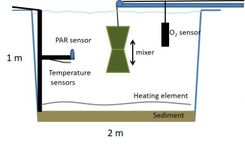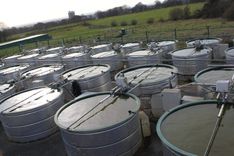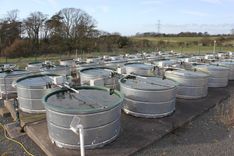Facilities
Transnational Access
Metadata & Data
Papers & Reports
Knowledge Base
CEH Aquatic Mesocosm Facility (CAMF)
Centre for Ecology & Hydrology (CEH)
Infrastructure Description
The CEH Aquatic Mesocosm Facility (CAMF) comprises 32 cylindrical insulated fibreglass outdoor mesocosms, each 1.0m deep and 2.0m in diameter (3000 l and 3 large fibreglass tanks 1.0m deep and 4.0m in diameter (12000 l) The latter are mainly used as storage reservoir for water and various freshwater species. The site was built in 2011 and is located 2 miles from the UKCEH office. Electric heating elements are placed in each mesocosm to allow for climate warming experiments. Temperature in warmed mesocosms can be increased by up to 5 °C above the ambient water temperatures, controlled by a custom computer program. To prevent thermal stratification, purpose-built mixers suspended in the middle of the mesocosm, can be moved slowly up and down through the water column and can be operated on different mixing regimes. All mesocosms are equipped with automatic sensors measuring temperature, dissolved oxygen and photosynthetically active radiation (PAR) every 5 minutes. A weather station within the mesocosm compound measures wind speed and direction, precipitation, air temperature, barometric pressure and relative humidity. All data is logged at five-minute intervals and directly transferred to a server. The site has been used for various climate change experiments, focussing on multiple stressors, such as brownification, warming, eutrophication and extreme rainfall events on freshwater communities.
Equipment is housed in a laboratory on site available for storage, working space and sample preparation. There is tap water access as well as raw water supply from a nearby reservoir. Fully equipped laboratories (including a FlowCam and microscopes with image analysis systems) are available at UKCEH Lancaster, housing the UKCEH Centralised Analytical Chemistry Group, maintaining high standards of quality control and UKAS-accredited to ISO17025. Various multiprobes are available for fieldwork: DS5X, EXO2, AlgaeTorch.

Facility Description
Outdoor – pelagic/benthic – freshwater
32 cylindrical insulated fibreglass outdoor mesocosms, each 1.0 m deep and 2.0 m in diameter (3000 L) arranged in four rows with eight mesocosms in each and 3 fibreglass tanks 1.0 m deep and 4.0 m in diameter (12000 L). The site was built in 2011 and is located around 2 miles from the CEH office.
Organisation Address
Centre for Ecology & Hydrology (CEH) Lancaster University
Library Avenue
Lancaster
LA1 4AP
United Kingdom
Infrastructure Address
Lancaster
United Kingdom
Information Sources
https://www.ceh.ac.uk/our-science/research-facility/aquatic-mesocosm-facility
Location
Gallery
Contacts
Heidrun Feuchtmayr
Stephen Maberly
Controlled Parameters
Depending on each individual experiment. So far:
- temperature
- nutrients
- precipitation (flushing)
- organic carbon
Research Topics
The site has been used for various climate change experiments so far, focusing on the effect of
- brownification on freshwater communities
- multiple stressors
- warming
- eutrophication
- extreme rainfall events.
Experiment Years
2011 - present
TA Support
Services currently offered by the infrastructure: Users can access offices and laboratories and various equipment as described above and receive necessary training and assistance during the experiment. So far, experiments have proven that the site is a very reliable facility, scalable for both large and small-scale studies. CAMF is a highly versatile site and can be used for an array of different applications: from short-term experiments of a few weeks, to long-term experiments over years. UKCEH Lancaster staff have 20 years of knowledge and expertise on running and managing mesocosm experiments. Accommodation can be provided by Lancaster University Bed and Breakfast or Lancaster University student accommodation.
Support offered under AQUACOSM-plus: Users will have access to CAMF, laboratories and instrumentation at UKCEH as described above and receive hands-on training if needed. Users will be part of an internationally renowned Lake Ecosystems group and cooperation with scientists at UKCEH Lancaster is strongly encouraged. UKCEH staff will support TA users to the best of their abilities before, during and after the experiment.
TA Modality of Access
At least 300 person-days in total will be allocated to external users supported by an AQUACOSM-plus TA activity. Approximately 7 visiting scientists over 43 days in one year are welcome to join ongoing experiments in M22-33. AQUACOSM-plus TA activities will be co-ordinated with other planned projects at the facility.
TA Accommodation
Lancaster University B&B


